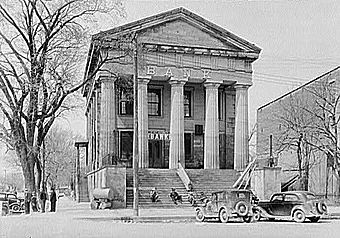Shawneetown Bank State Historic Site facts for kids
Quick facts for kids |
|
|
State Bank
|
|

Main Street front in 1937
|
|
| Location | Corner of Main St. and Washington Street, Old Shawneetown, Illinois |
|---|---|
| Area | 0.7 acres (0.28 ha) |
| Built | 1839–41 |
| Architectural style | Greek Revival |
| NRHP reference No. | 72000459 |
| Added to NRHP | April 19, 1972 |
The Shawneetown Bank State Historic Site is an old bank building in Old Shawneetown, Illinois. It is the oldest building in Illinois made just for a bank. This building was constructed between 1839 and 1841. It is designed in the Greek Revival style, which looks like ancient Greek temples. For many years, this building was home to different banks. It is made of brick with a special limestone front.
Why Shawneetown Needed a Bank
A Busy River Town
Long ago, Old Shawneetown, Illinois was a very important place. It was known as the "gateway" to the Illinois Territory. This meant it was a main entry point for people coming into the area. It was also a big business center for early Illinois.
Salt and Land Sales
The area was rich in salt, which was a valuable resource. A special government office, called a federal land office, opened there in 1812. This office sold land to new settlers. People needed money to buy land and do business. This is why banks became so important in Shawneetown.
The First Banks in Illinois
In 1816, the Illinois government allowed four private banks to open. The very first bank in the Illinois Territory was called the Bank of Illinois. It was also known as the Bank of Illinois at Shawneetown. Governor Ninian Edwards approved this bank on December 28, 1816. At first, the bank operated right out of its owner's home.
Challenges for Early Banks
The first Bank of Illinois stopped working around 1823 or 1824. But in 1835, the state government decided to bring it back. They renamed it the State Bank of Illinois at Shawneetown. In 1837, the bank was allowed to have much more money.
However, a big money problem called the Panic of 1837 hit the country. People rushed to banks to get their money in gold or silver coins. The Shawneetown bank could not give out enough coins. The state government allowed the bank to stop giving out coins for a while. Even with these problems, bankers felt hopeful about the future.
Building the Bank and Its History
A Grand New Building
The famous bank building we see today was built in 1839 and 1840. It cost a lot of money, about $80,000. The first stone was placed on August 3, 1839. The bank officially opened its doors in 1841. It was located at the corner of Main Street and what was then called Main Cross Street.
Helping the State
The State Bank of Illinois did more than just help regular people. It also loaned money to the state government. For example, it loaned $80,000 to help finish the state capitol building in Springfield. The bank also loaned a lot of money for public projects. However, much of this money was never paid back.
The Bank Closes and Reopens
In June 1842, the bank finally closed down. It still had many banknotes, which are like paper money, that people were using. The bank building was then sold for $15,000 to Joel A. Matteson.
In 1853, Matteson, who was then the governor, opened a new bank in the same building. He called it the State Bank of Illinois.
Changing Hands During War
When the American Civil War began, Governor Matteson worried that Confederate soldiers might attack the area. So, he closed the bank and sold the building for only $6,500. A man named Thomas S. Ridgway bought it.
Ridgway lived in the building. In 1865, he and John McKee Peeples started a new bank there called The First National Bank of Shawneetown. Both Ridgway's home and the new bank were in the building in the mid-1870s. The building continued to house different banks and financial businesses through the 1930s.
The Bank Today
Becoming a Historic Site
Eventually, the bank building was given to the state of Illinois. In 1972, the Shawneetown Bank was added to the National Register of Historic Places. This means it is a special building recognized for its history.
Restoration Efforts
Some work was done in the 1970s to fix up the building. But much more was still needed. In 2009, a group called Landmarks Illinois listed it as one of the top 10 most endangered historic sites. This means it was in danger of falling apart. As of 2017 and 2020, the bank building was not open for public tours.



